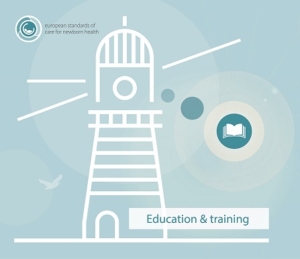
A guest article by Dr Rangmar Goelz and Dr Karen Kreutzer from the University Children’s Hospital Tübingen
Last year, the neonatal ward in the University Clinic Tübingen/Germany started, as one of the first clinics in Germany, to train emergency situations with the help of a baby simulator doll. As this in one of our lighthouse projects in the area “Education and training”, we spoke to Dr Rangmar Goelz and Dr Karen Kreutzer and asked them how the simulation trainings have been implemented into their training schedules and if the trainings have proven to be successful.

The University Children’s Hospital Tübingen is one of the first clinics in Germany that is using a baby simulator doll for training purposes. How did that come about?
We already started training our staff in a simulation laboratory 12 years ago. This laboratory was initially used for trainings in anaesthesiology, but it was soon used in paediatrics as well.
At the beginning we only had a doll weighing 4–5 kg. This of course was too big, but it was good enough to practice various emergency scenarios. During these trainings even the biggest sceptics in our team were able to experience how real it feels and how the blood pressure increases in such a simulated emergency situation. So right from the beginning we were completely convinced about the concept of simulation trainings in general.
For how long are you using the simulator doll Paul and why did you make the decision to integrate it into your trainings?
We heard about the simulator doll Paul at a congress and we immediately contacted the manufacturer. Paul was the missing piece to make the simulation even more realistic and adapt it even better to our every-day work at the hospital. So we were very happy when we finally received our own Paul. As the costs for the doll are quite high, we appreciated the financial support we received from the local newspaper “Schwäbisches Tagblatt”, the foundations Dachtel hilft kranken Kindern and Lichtblick e.V. , and our own parent initiative for ill children of the University Children’s Hospital Tübingen.
How do you integrate Paul into your simulation trainings in your hospital?
In the beginning we practiced mostly in our simulation laboratory because we also had to first become familiar with the doll. It is quite surprising how similar it is with a real preterm baby and how small and fragile it is. We practiced using the doll in different scenaries covering first stabilisation measures and the typical associated ermergency situations. Recently we started training with Paul outside of the laboratory directly in the neonatal ward, as Paul has another great feature: he functions wirelessly via radio control, therefore we can hold our training sessions in the actual places of action which makes it even more realistic.
How would you like to further develop the simulation trainings?
As I said, we are currently training for stabilisation scenarios that are typical for the emergency cases in the neonatal ward. But our goal is to do trainings directly in intensive care, but for this we need free beds in intensive care, which is at the moment very difficult.
What are the challenges you are facing?
One of the biggest challenges is to allocate the time that you need for the training units. The simulation trainings can only be conducted in a team, with the participation of nurses, the ward doctor, one or two senior doctors, and the training staff. This means that the trainings need to be scheduled very far ahead, and so far the trainings are not included in the general staff planning and need to be added on top. In Germany the number of nurses allocated to the care of preterm babies with very low birth weight was increased, so we now have more nursing staff. Unfortunately this not the case yet with doctors.
What changes and improvements were you able to achieve so far by practising with Paul?
The training conditions are becoming more and more realistic. So far we did not make a review of our experiences in the classical sense to show what the benefits of our baby simulation training really are. This would also exceed our administrative capacities. But maybe I could illustrate how we are benefitting from it by telling you about a situation the other day in our ward: In was in the middle of the night, and besides taking care of normal patients, we had a severe emergency situation and an emergency C-section of a very preterm baby. It was very late, everyone was stressed out and we had many other patients, but everything went perfectly smooth. This was a very satisfying and comforting experience for the whole team, which can be especially important even when all efforts fail and we cannot help the child in the end.
View more (article by Dr Jens-Christian Schwindt, founder of the baby simulator doll Paul)
Special thanks


View more (website University Clinic Tübingen)

The simulator doll Paul is being used for trainings in the following clinics around the globe:
USA:
Germany:
Austria:
Scotland:
Kasachstan:
Turkey:
You are currently viewing a placeholder content from Facebook. To access the actual content, click the button below. Please note that doing so will share data with third-party providers.
More InformationYou are currently viewing a placeholder content from Instagram. To access the actual content, click the button below. Please note that doing so will share data with third-party providers.
More InformationYou are currently viewing a placeholder content from X. To access the actual content, click the button below. Please note that doing so will share data with third-party providers.
More Information